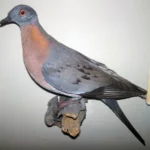The rock pigeon is one of the pigeons that we see most frequently in our area. But how many of us are familiar with these city birds? Here is a table listing their fundamental attributes.
| Breed name | Rock |
| Other name | Pigeon, rock dove, rock pigeon, blue rock dove |
| Scientific name | Columba livia |
| Breed class | Average |
| Special features | Good looking, active, food flying capacity, handy, long-lived, can be kept as pets |
| Flying ability | Good |
| Purpose | Wild or feral |
| Length | 31-34cm |
| Wingspread | 63-70cm |
| Weight | 238-380 grams |
| Eye colors | Red |
| Feather color | Black, blue, brown, cream, gray, purple, pink, and white |
| Beak color | Black |
| Leg color | Pink, brown, and red |
| Colors | Gray |
| Body structure | Plump |
| Neck | Short |
| Head | Small |
| Sexual maturity | 140 days |
| Can be kept as pets | Yes |
| Habitat | Open and semi-open environments |
| Native origin | Europe, North Africa, and southwestern Asia |
| Breeding time | Spring and summer (peak) |
| Food habit | Omnivorous but prefers plant materials like grains and fruits |
| Average speed | Good |
| Average lifespan (average) | Wild: 6 years Captivity: Up to 35 years |
The rock pigeon is an ancient bird. They have a long history with humans, and it is almost impossible to trace the bird’s origin, date, or era. Below, we will discuss rock pigeons’ characteristics and the associated facts.
What is a rock pigeon?
Have you noticed pigeons swarming to open city spaces to eat grains or other leftover food? Those are the common pigeons that frequent the area. But do we know what they are called?
Aka rock doves, rock pigeons are birds in the Columbidae family. These are also known as city birds and can be found in large cities worldwide, swarming streets, parks, buildings, and other urban areas. Rocks pigeons are also known simply as “pigeons.”
These pigeons come in many other hues and patterns besides their common gray color. There are many places where rock pigeons can be found, including clearings, wooded areas, building creeks, etc. Rock pigeons are the ancestors of both domestic and wild pigeons.

Here is a fun fact about rock pigeons– Before the British Ornithologists’ Union and the American Ornithologists’ Union changed their prevailing official English name, these birds were known as rock doves.
Rock pigeon types
Rock pigeons are wild pigeon species. However, they have been domesticated for a long time, giving rise to numerous types. Pigeons that eluded domestication turned into feral birds.
Below is a list of different pigeons that evolved from the rock pigeon species.
- Homing pigeons
- Racing pigeons
- Fancy pigeons
- War pigeons
- Messenger pigeon
How to identify rock pigeons?
There are different types of pigeons- from rock pigeons and carrier pigeons to racing pigeons. So, it is worth learning the ways to identify rock pigeons.
Here are a few characteristics to determine whether they are rock pigeons.
- Length of 30–35 cm
- Wingspan: 62–68 cm
- Greyish-white wings
- Lower back in white (pure rock pigeons)
- Grayish-bluish coat color (in most cases)
- Orange or red eyes
- The wings have two black bands.
- White tail tip
- Iridescent throat feather
- The neck and head are blue-gray
- Red plumage rock pigeons are more common in the southwest than in the north and east.
Cools facts about rock pigeons/ pigeons
Pigeons may look like naïve urban birds, but there are things that these birds can do pretty well. Want to learn some cool facts about rock pigeons? Here they are.
- Pigeons can fly quickly.
- Even when blindfolded, they can find their way home.
- Pigeons use magnetic fields to determine which way to fly.
- During World Wars I and II, rock pigeons were used as messengers or carriers of messages.
- Rock pigeons are available in a variety of colors.
- Domestic rock pigeons, also known as homers, are raised to be racing pigeons.
How to feed rock pigeons?
Did we say that rock pigeons are omnivorous? Yes, you heard that right. But what and how to feed them? Let’s explore the answer.
Typically, wild or feral rock pigeons eat seeds, grains, and fruits. Experts estimate that the main components of these pigeons’ diet are 92% maize, 3.2% oats, 3.7% cherries, and small amounts of knotweed. In parks and gardens, they have also been observed eating berries and grass seeds.
If you want to feed these domesticated birds the following food:
- Seeds (but not all seed diet)
- Grains (best seeds + grains)
- Pelleted diets
- Fruits
- Vegetables
- Water
Pigeons are typically lactose intolerant. So, dairy products shouldn’t be fed to them. You can give these birds any other wholesome food, including cooked meat, eggs, fish, and other human foods. But keep in mind to only feed this food occasionally and in small amounts.
However, based on a variety of reviews, we have noted that it is always preferable to give doves and pigeons properly mixed seeds.
How to train a rock pigeon?

Pigeons may have small heads, but they are pretty good and intelligent. They can follow instructions, and you can train them to fly to you. So, let’s see how you do it.
Wild rock pigeons do not need to be trained. But if you are domesticating them, you can surely train them. Follow the tips below to aid the training of your pigeons.
- Create a comfortable loft or home for the pigeons.
- The lofts should be roomy, cozy, and equipped with enough food and water.
- Avoid packing too many birds into one loft.
- Place the loft in a space that is open and free of obstacles so that the pigeons can fly from it.
- When your birds are at least 6 weeks old, begin training them.
- Build two lofts if you’re getting your birds ready for a race; one should serve as the starting line and the other as the finish line.
- Create a trap door on the arrival loft so the birds can fly in but not out.
- Release the birds first about a half-mile from their loft.
- Several times a week, practice releasing.
- Start moving the lofts farther apart by 5 miles every week.
Here are some added tips for you:
- Buy pigeons in pairs only.
- Never increase the flying distance too quickly or for an extended period.
- You should reevaluate your training method if you frequently lose your pigeons.
- Wait for your pigeons’ return if they get lost; it might take them a few days to find their way home.
- Local pigeon clubs are the place to go to report a lost pigeon.
How to breed rock pigeons?

It is pretty interesting to note that pigeons are monogamous. They breed in consecutive seasons if the birds in the pair continue to live.
Remember that with being monogamous, pigeons are very territorial. So, create a comfortable loft for them during the mating season. Verify the breeding pair’s well-being and the cleanliness of the loft. Nest, you should pre-couple the pair so that they become comfortable with each other. Lastly, keep their nesting box separately away from any chaos.
Here are some additional actions you should take to maintain the breeding pigeons’ well-being.
- Because pigeons enjoy sunbathing, they built their loft in a sunny location.
- A pigeon bath should be placed close to the loft as well.
- Give the nesting pigeons a healthy diet.
- Twice a year, pigeons should be dewormed.
Rock pigeon vs feral pigeon
It can be challenging to distinguish pigeons from other birds. The difficulty increases when attempting to distinguish between a rock and a feral pigeon.
Pigeons that escape domestication turn feral and live on the ledges of structures, trees, and other locations. Essentially, rock pigeons are the ancestors of feral pigeons. They are the same species as domestic and feral pigeons.
Pure rock pigeons are rare, mostly found in either homers or feral populations.
Summary
So, here is our take on the characteristics of rock pigeons. We hope you found this post engaging and informative. From next time onwards, whenever you encounter a pigeon, use the facts above to identify it rightly. These city birds are amazing; learning about them would make them even more fascinating.



